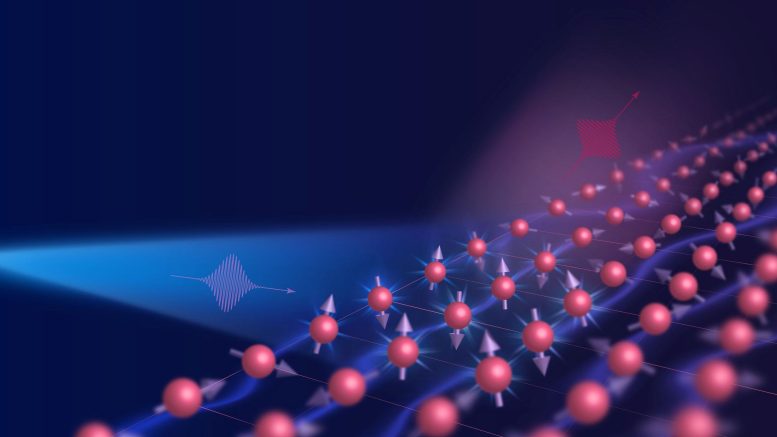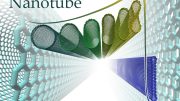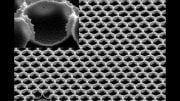
Resonant inelastic X-ray scattering reveals high-energy nematic spin correlations in the nematic state of the iron-based superconductor, FeSe. Credit: Beijing Normal University/Qi Tang and Xingye Lu
Electronic nematicity, thought to be an ingredient in high-temperature superconductivity, is primarily spin driven in FeSe finds a study in Nature Physics.
Researchers from PSI’s Spectroscopy of Quantum Materials group together with scientists from Beijing Normal University have solved a puzzle at the forefront of research into iron-based superconductors: the origin of FeSe’s electronic nematicity. Using Resonant inelastic X-ray scattering (RIXS) at the Swiss Light Source (SLS), they discovered that, surprisingly, this electronic phenomenon is primarily spin-driven. Electronic nematicity is believed to be an important ingredient in high-temperature superconductivity, but whether it helps or hinders it is still unknown. Their findings are published in the journal Nature Physics.
Near Paul Scherrer Institute (PSI), where the Swiss forest is ever present in people’s lives, you often see log piles: incredibly neat log piles. Wedge-shaped logs for firewood are stacked carefully lengthways but with little thought to their rotation. When particles in a material spontaneously line up, like the logs in these log piles, such that they break rotational symmetry but preserve translational symmetry, a material is said to be in a nematic state.
In a liquid crystal, this means that the rod-shaped molecules are able to flow like a liquid in the direction of their alignment, but not in other directions. Electronic nematicity occurs when the electron orbitals in a material align in this way. Typically, this electronic nematicity manifests itself as anisotropic electronic properties: for example, resistivity or conductivity exhibiting radically different magnitudes when measured along various axes.
The past decade has seen enormous interest in the family of iron-based superconductors since their discovery in 2008. Alongside the well-studied cuprate superconductors, these materials exhibit the mysterious phenomenon of high-temperature superconductivity. The electronic nematic state is a ubiquitous feature of iron-based superconductors. Yet, until now, the physical origin of this electronic nematicity was a mystery; in fact, arguably one of the most important mysteries in the study of iron-based superconductors.
But why is electronic nematicity so interesting? The answer lies with the ever-exciting conundrum: understanding how electrons pair up and achieve superconductivity at high temperatures. The stories of electronic nematicity and superconductivity are inextricably linked – but exactly how, and indeed whether they compete or cooperate, is a hotly debated issue.
The drive to understand electronic nematicity has led researchers to turn their attention to one particular iron-based superconductor, iron selenide (FeSe). FeSe is somewhat of an enigma, simultaneously possessing the most simple crystal structure of all the iron-based superconductors and the most baffling electronic properties.
FeSe enters its superconducting phase below a critical temperature (Tc) of 9 K but tantalizingly boasts a tunable Tc, meaning that this temperature can be raised by applying pressure to or doping the material. The quasi-2D layered material possesses an extended electronic nematic phase, which appears below approximately 90 K. Curiously, this electronic nematicity appears without the long-range magnetic order that it would typically go hand in hand with, leading to lively debate surrounding its origins: namely, whether these are driven by orbital- or spin-degrees of freedom. The absence of long-range magnetic order in FeSe gives the opportunity to have a clearer view of the electronic nematicity and its interplay with superconductivity. As a result, many researchers feel that FeSe may hold the key to understanding the puzzle of electronic nematicity across the family of iron-based superconductors.
Measuring the spin excitation anisotropies with Resonant inelastic X-ray scattering (RIXS)
To determine the origin of FeSe’s electronic nematicity, scientists from PSI’s Spectroscopy of Quantum Materials Group turned to the technique of resonant inelastic X-ray scattering (RIXS) at the ADRESS beamline of the Swiss Light Source (SLS). Combining the principles of X-ray absorption and emission spectroscopies, this technique is a highly efficient tool to explore the magnetic or spin excitations of a material.
“At PSI, we have one of the most advanced set-ups for RIXS in the world. Among the first to push this technique 15 years ago, we have now established a very well developed facility for this type of experiments,” explains Thorsten Schmitt, who led the study together with Xingye Lu from Beijing Normal University. “In particular, the characteristics of the synchrotron radiation due to the SLS ring design are ideal for the soft x-ray range that these experiments were performed in.”
To study the spin anisotropies of FeSe using RIXS, the scientists first needed to overcome a practical hurdle. In order to measure the anisotropic nematic behavior, the sample first needed to be ‘detwinned’. Twinning occurs when crystals in stacked layers are aligned with the same probability along arbitrary directions, thus concealing any information about anisotropic behavior. Detwinning is a common crystallographic sample preparation technique, where typically a pressure is applied to the sample that causes the crystals to align along structural directions.
For FeSe, this doesn’t work. Apply this pressure to FeSe and the soft material simply deforms – or breaks. Therefore, the team used a method of indirect detwinning, whereby FeSe is glued to a material that can be detwinned: barium iron arsenide (BaFe2As2). “When we apply a uniaxial-pressure to BaFe2As2, this generates a strain of around 0.36%, which is just enough to detwin FeSe at the same time,” explains Xingye Lu, who had previously demonstrated its feasibility together with Tong Chen and Pengcheng Dai from Rice University for studies of FeSe with inelastic neutron scattering.
Inelastic neutron scattering experiments had revealed spin-anisotropies in FeSe at low energy; but measurement of high-energy spin excitations, were essential to link these spin fluctuations to the electronic nematicity. Measuring spin excitations at an energy scale of about 200 meV – well above the energy separation between the orbital energy levels – would enable orbital degrees of freedom to be ruled out as a source of the electronic nematicity. With detwinning successfully accomplished, the researchers could probe the crucial high-energy spin excitations of FeSe, and also BaFe2As2, using RIXS.
The researchers investigated spin anisotropy in the Fe-Fe bond direction. To judge the spin anisotropy, the team measured spin excitations along two orthogonal directions and compared the responses. By performing measurements under increasing temperature, the team could determine the critical temperature at which nematic behavior disappeared, and compare observations of spin anisotropies to electronic anisotropies, observed through resistivity measurements.
The researchers first measured detwinned BaFe2As2, which has a well-characterized, anisotropic spin-structure and long-range magnetic order, and used this as a reference. Measurements of the spin excitation response along the two orthogonal directions showed a clear asymmetry: the manifestation of the nematicity.
The team then performed the same experiment in detwinned FeSe. Despite the lack of magnetic ordering, they observed a very strong spin anisotropy with respect to the two axes. “Extraordinarily, we could reveal a spin anisotropy comparable – if not greater – to that in the already highly anisotropic BaFe2As2,” says Xingye Lu. “This spin anisotropy decreases with increasing temperature, and disappears around the nematic transition temperature – the temperature at which the material ceases to be in an electronic nematic state.”
The origin of electronic nematicity in FeSe: towards a better understanding of electronic behavior in iron-based superconductors
The energy scale of the spin excitations of around 200 meV, which is much higher than the separation between the orbital levels, demonstrates that the electronic nematicity in FeSe is primarily spin-driven. “This was a big surprise,” explains Thorsten Schmitt. “We could now make the connection between electronic nematicity, manifesting as anisotropic resistivity, with the presence of nematicity in the spin excitations.”
But what do these findings mean? The interplay between magnetism, electronic nematicity, and superconductivity is a key issue in unconventional superconductors. It is believed that quantum fluctuations of electronic nematicity may promote high-temperature superconductivity in iron-based superconductors. These findings provide a long-sought-after insight into the mechanism of electronic nematicity in FeSe. But more broadly, they add an important piece to the puzzle of understanding electronic behavior in iron-based superconductors, and ultimately, how this links to superconductivity.
The next steps will be to find out if spin-driven electronic nematic behavior persists in other members of the iron-based superconductor family, and furthermore, whether suspicions that it can arise along other directions than the Fe-Fe bond axis are correct.
Reference: “Spin-excitation anisotropy in the nematic state of detwinned FeSe” by Xingye Lu, Wenliang Zhang, Yi Tseng, Ruixian Liu, Zhen Tao, Eugenio Paris, Panpan Liu, Tong Chen, Vladimir N. Strocov, Yu Song, Rong Yu, Qimiao Si, Pengcheng Dai and Thorsten Schmitt, 19 May 2022, Nature Physics.
DOI: 10.1038/s41567-022-01603-1









Be the first to comment on "Electronic Nematicity: Spin Keeps Electrons in Line in Iron-Based Superconductor"